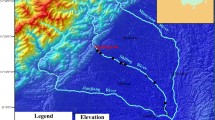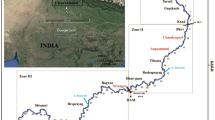Abstract
On March 11, 2011 (Heisei 23) a large earthquake and tsunami hit the coastline along Miyagi Prefecture, Japan, with catastrophic consequences by heavily impacting beaches, lagoons, wetlands, rivers and estuaries. The lower watershed of the Minato River (Minatogawa) and its mildly urbanized estuary, as well as the surrounding area, suffered heavy damage due to ground subsidence, sediment deposition, wave erosion, abrasion and flooding. Local authorities developed plans for reconstruction and rehabilitation of the river and its estuary. Work started in earnest by 2013, which included the construction of a L1 type levee. The impacts of the engineering-related works and structures to be built are expected to be large, particularly for the levee, likely putting in doubt their environmental sustainability.
Access this chapter
Tax calculation will be finalised at checkout
Purchases are for personal use only
Similar content being viewed by others
Notes
- 1.
A partially submerged river valley mostly surrounded by mountains with a long, narrow inlet.
- 2.
Although the Chilean Tsunami of 1960 also had a large impact it can be considered as minor when compared to the Showa and Heisei events.
- 3.
The inundation map was produced in ArcGIS (ESRI). Flooded areas were referred to those in the tsunami inundation map by the Association of Japanese Geographers-AJG- (http://map311.ecom-plat.jp/map/map/?mid=40). The basic geospatial information (kibanchizu-joho) was taken from the Geospatial Information Authority of Japan (GSI/MLIT) (http://fgd.gsi.go.jp/download/).
- 4.
References
Adityawan BM, Roh M, Tanaka H, Farid M (2012) The effect of river mouth morphological features on tsunami intrusion. Proceedings of the 8th international conference on disaster management (CD-ROM), pp 75–83. http://www.iiirr.ucalgary.ca/files/iiirr/A4-1_.pdf. Accessed Apr 2015
Atsumi M (2009) River Bureau, Ministry of Land, Infrastructure, Transport and Tourism, Japan. http://www.mlit.go.jp/river/basic_info/english/pdf/conf_05.pdf. Accessed Jan 2015
Biodiversity Center of Japan (2013) Impacts of the Great East Japan earthquake on the natural environment in Tohoku Coastal Regions. Nature Conservation Bureau; Ministry of the Environment, Japan. http://www.shiokaze.biodic.go.jp/PDF/pamphlet_en.pdf. Accessed Jan 2015
Clilverd H, Thompson J, Heppell K, Sayer C, Axmacher J (2015) Removal of river embankments and the modelled effects on river-floodplain hydrodynamics. Geophys Res Abstr 17, EGU2015-12974-1, 2015 EGU General Assembly 2015. http://meetingorganizer.copernicus.org/EGU2015/EGU2015-12974-1.pdf. Accesed Mar 2015
Dawson AG (1994) Geomorpholical effects of tsunami run-up and backwash. geomorphology 10(1–4):83–94. http://www.sciencedirect.com/science/article/pii/0169555X94900094. Accessed Jan 2015
Ellis JT, Sherman DJ (2015) Coastal and marine hazards, risk and disaster. Elsevier. https://books.google.com.mx/books. Accessed May 2015
Godou H (2010) River Basin management in Japan. Flood control measures-water resource management. Ministry of Land, Infrastructure, Transport and Tourism, Japan. http://www.mlit.go.jp/river/basic_info/english/pdf/conf_04-0.pdf. Accessed Apr 20145
Grzelak K, Szczuciński W, Kotwicki L, Sugawara D (2013) Ecological status of sandy beaches after tsunami events – insights from meiofauna investigations after the 2011 Tohoku-oki tsunami, Sendai, Japan. In: Kontar Y, Santiago V, Takahashi T (eds) Tsunami events and lessons learned; environmental and societal significance. Springer International Publishing AG. Cham, Switzerland
Hirano K (2013) Difficulties in post-tsunami reconstruction plan following Japan’s 3.11 mega disaster: dilemma between protection and sustainability. J JSCE 1:1–11. https://www.jstage.jst.go.jp/article/journalofjsce/1/1/1_1/_pdf. Accessed Apr 2015
Imamura F, Anawat S (2012) Proceedings of the international symposium on engineering lessons learned from the 2011 Great East Japan earthquake, March 1–4, 2012, Tokyo, Japan. http://www.jaee.gr.jp/event/seminar2012/eqsympo/pdf/papers/118.pdf. Accessed Apr 2015
Inoue M, Kamogawa M (2012) The need to change the concept of water-related disaster prevention. Sci Technol Trends. http://www.nistep.go.jp/en/wp-content/uploads/NISTEP-STTO044-1E.pdf. Accessed Apr 2015
Iuchi K, Maly E, Johnson L (2014) Three years after a Mega-disaster: recovery policies, programs and implementation after the Great East Japan earthquake. In: Santiago-Fandiño V, Kontar Y, Kaneda Y (eds) Post-tsunami hazards: reconstruction and restoration. Springer, International Publishing AG. Cham, Switzerland
Japan Red Cross Society (2013) Evaluation of the JRCS and IFCR recovery and rehabilitation interventions after the Great East Japan earthquake and tsunami of 11 March 2011. Final report. September 2013. http://www.jrc.or.jp/vcms_lf/JPTsunamiEarthquakeEvaluationSEP2013.pdf. Accessed Apr 2015
Japan Water Forum (2012) http://www.waterforum.jp/eng/2011/Japan_Earthquake/matsushima/investigation/top_main_r.html#top. Accessed Dec 2014
JCOLD–Japan Commission on Large Dams (2009) Dams in Japan; past, present and future. CRC Press, Page 60. https://books.google.pl/books?id=If54C_G7.....ione%20typhoon%201948%20Japan&f=false. Accessed July 2015
Kamiyama M, Sugito M, and Kuse M (2012) Precursor of crustal movements before the 2011 Great East Japan earthquake. Proceedings of the international symposium on engineering lessons learned from the 2011 Great East Japan Earthquake, March 1–4, Tokyo, Japan. http://www.jaee.gr.jp/event/seminar2012/eqsympo/pdf/papers/8.pdf. Accessed Dec Jan 2014
Keller RK, Finlayson M, Humphries P (2015) Restoring and conserving nature in the anthropocene means changing our ideas of success. The conservation. September 7. https://theconversation.com/restoring-and-conserving-nature-in-the-anthropocene-means-changing-our-idea-of-success-42691. Accessed Sept 2015
Komatsu G, Goto K, Baker RV, Oguchi T, Hayakawa SY, Saito H, Pelletier JD, McGuire L, Iijima Y (2013) Effects of tsunami wave erosion on natural landscapes: examples from the 2011 Tohoku-oki tsunami. In: Kontar Y, Santiago V, Takahashi T (eds) Tsunami events and lessons learned; environmental and societal significance. Springer International Publishing AG. Cham; Switzerland
Matsuura K, Shinohara G, Nakae M (2009) Historical fish specimens collected from the Tohoku district by the Saito Ho-on Kai Museum of natural history. Bull Natl Mus Nat Sci Ser A 35(1):9–54. https://www.kahaku.go.jp/research/researcher/papers/211053.pdf. Accessed Mar 2015
MLIT–Ministry of Land, Infrastructure, Transport and Tourism, Japan (2014a) http://www.mlit.go.jp/river/toukei_chousa/kasen/jiten/nihon_kawa/map_82.html - in Japanese. Accessed Jan 2014
MLIT–Ministry of Land, Infrastructure, Transport and Tourism, Japan (2014b) White paper. creating and preserving a beautiful and healthy environment. Promoting counter measures against global warming, Section 1. https://www.mlit.go.jp/common/001063088.pdf. Accessed Apr 2015
Mori N, Takahashi T, Yasuda T, Yanagisawa H (2011) Survey of 2011 Tohoku earthquake tsunami inundation and run-up. Geophysical research letters, vol 38. http://onlinelibrary.wiley.com/store.…. Accessed Mar 2015
MPG (Miyagi Prefectural Government) (2011) Overview of the rivers in jurisdiction area (in Japanese). http://www.pref.miyagi.jp/soshiki/ks-doboku/river001.html. Accessed May 2015
MPG (Miyagi Prefectural Government) (2014) Miyagi prefecture, river bank recovery (Minato River) (in Japanese). http://www.pref.miyagi.jp/uploaded/attachment/203358.pdf. Accessed May 2015
MT (Minamisanriku Town-Minatogawa –Utatsu-) (2015) Virtual museum (in Japanese). http://www.town.minamisanriku.miyagi.jp/museum/natural/article.php?p=34. Accessed May 2015
Nagasawa T, Tanaka H (2012) Study of structural damages with massive geomorphic change due to tsunami. International conference on disaster management/IIIRR annual international conference, Kumamoto, Japan. http://www.iiirr.ucalgary.ca/files/iiirr/A6-3_.pdf. Accessed Apr 2015
Nakagoshi N, Inoue M (2003) Rivers system in Japan from a landscape ecological aspect. J Environ Sci 15(2):160–166. Accessed 1 Dec 2014. www.jesc.ac.cn/jesc_cn/ch/reader/create_pdf.aspx?file_no
Nakamura K (2008) River restoration efforts in Japan. Overview and perspective. Public Works Research Institute, Japan. http://www.pwri.go.jp/eng/activity/pdf/reports/k.nakamura.080601.pdf. Accessed Feb 2015
Nakamura S (2015) Designing a deluge: history of the estimating method of flood designing. Japan technology and industry working group. Thinking about technology in history of modern Japan (19th–20th century). Technology in Modern East Asia History Workshop. June 11–12; 2015, UK. Daily Archives, April 27, 2015. http://japantech.hypotheses.org/date/2015/04/27. Accessed July 2015
Nakamura K, Tockner K, Amano K (2006) River and wetland restoration: lessons from Japan. Bioscience (Oxford). May 2006/vol. 56, no 5. http://bioscience.oxfordjournals.org/content/56/5/419.abstract. Accessed Apr 2015
NAS -National Academy of Science- (2012) Levees and the national flood insurance program. Report summary. Water Science and Technology Board. http://nas-sites.org/levees/report-summary/. Accessed Apr 2015
Oka F, Tsai P, Kimoto S, Kato R (2012) Damage pattern of river embankments due to the 2011 off the Pacific Coast of Tohoku earthquake and numerical modeling of the deformation of the river embankments with a clayey subsoil layer. Elsevier. Soils and Foundations 52(5):890–909, Oct 2012
Omachi T (1999) The river law with a commentary article. Legal framework for river and water management in Japan. Ministry of Construction; Infrastructure Development Institute-Japan. IDI water series no 4. http://www.idi.or.jp/library/pdf/RIVERE.PDF. Accessed 1 Dec 2014
Roh M, Bagus MA, Tanaka H (2014) Assessment of propagation characteristics for tsunami wave ascending river. Coastal engineering proceedings, no. 34. https://icce-ojs-tamu.tdl.org/icce/index.php/icce/article/view/7302/pdf_717. Accessed Apr 2015
S&TT (2012) Executive summary. Science and technology trends. Executive summary. http://www.nistep.go.jp/en/wp-content/uploads/NISTEP-STTO044-1E.pdf. Accessed Apr 2015
SAFOA and US Corps of Engineers (2015) American river watershed; draft environmental impact statement. Environmental impact report. http://yosemite.epa.gov/oeca/webeis.nsf/(eisdocs)/20150071/$file/american%20river%20common%20features%20draft%20eiseir.pdf?openelement. Accessed Apr 2015
Santiago-Fandiño V (2013) The tsunami and earthquake in Miyagi prefecture and sanriku coastline environmental, economic and social aspects 2011–2012. In: Kontar Y, Santiago V, Takahashi T (eds) Tsunami events and lessons learned; environmental and societal significance, 2013. Springer International Publishing AG. Cham, Switzerland
Santiago-Fandiño V, Kim MH (2015) Tsunami and environmental pollution: a note for the restoration process. In: Santiago-Fandiño V, Kontar Y, Kaneda Y (eds) Post-tsunami hazards; reconstruction and restoration. Springer International Publishing AG. Cham, Switzerland
Shadanhojin Tohoku Kensetsu Kyokai (2012) Tsunami Hisai Zengo no Kiroku. Kahoku Shimpo Publishing Centre, Sendai, Japan
Shi S (2003) Coastal tsunami geomorphological impacts and sedimentation processes: case studies of modern and prehistorical events. International conference on Estuaries and Coasts Nov 9–11, 2003, Hangzhou, China. http://www.irtces.org/pdf-hekou/021.pdf. Accessed Jan 2015
Shimazu H (2012) Geomorphic impacts of the 2011 tsunami on the lower reaches of the R. Natori, northeast Japan. Geophy Res Abstr 14:EGU2012-8986, 2012. http://meetingorganizer.copernicus.org/EGU2012/EGU2012-8986.pdf. Accessed Jan 2014
Shuto N, Fujima K (2009) A short history of tsunami research and countermeasures in Japan. Proc Jpn Acad Ser B Phys Biol Sci 85(8):267–275. http://www.ncbi.nlm.nih.gov/pmc/articles/PMC3621565/. Accessed Mar 2015
Taisei Corporation (2013) Development of cement-hardened material production technology for effective use of concrete rubble. 2013. JSCE Environmental Award Winning Technology. http://www.jsce.or.jp/committee/concrete/e/newsletter/newsletter39/Newsletter39_files/data/jsce%20award/3.pdf. Accessed June 2015
Tanaka H, Kayane K, Bagus A M, Farid M (2013) The effect of bed slope to the tsunami intrusion into rivers. Coastal Dynamics. http://www.coastaldynamics2013.fr/pdf_files/154_Tanaka_Hitoshi.pdf. Accessed Apr 2015
Tanaka H, Kayane K, Adityawan M B, Roh M, Farid M (2014) Study on the relation of river morphology and tsunami propagation in rivers. Ocean Dyn 64:1319–1332. Springer. http://link.springer.com/article/10.1007/s10236-014-0749-y. Accessed Apr 2015
Tohoku Regional Bureau (MILT) (2015) Occurrence of the earthquake and tsunami approaching. Earthquake memorial museum. http://infra-archive311.jp/en/w01.html. Accessed Apr 2015
Tsuji Y, Satake K, Ishibe T, Harada T, Nishiyama A, Kusumoto S (2014) Tsunami heights along the Pacific Coast of Northern Honshu recorded from the 2011 and previous great earthquakes. Pure Appl Geophys 171(2014):3183–3215. http://download.springer.com/static/pdf/977/art%253A10.1007%252Fs00024-014-0779-x.pdf?auth66=1418721876_e3448ac2d7495cdc9f3d6cd6a3afaca7&ext=.pdf. Accessed Dec 2014
Udo K, Takeda Y, Takamura M, Mano A (2015) Serious erosion of the southern Sendai Coast due to the 2011Tohoku Earthquake Tsunami and its recovery process. In: Santiago V, Kontar Y, Kaneda Y (eds) Post tsunami hazards; reconstruction and restoration, 2013. Springer, International Publishing AG. Cham, Switzerland
Wikipedia-Japan (2014) http://ja.wikipedia.org/wiki/宮城県の二級水系一覧. Accessed Dec 2014
Yoshimura C, Omura T, Furumai H, Tockner K (2005) Present state of rivers and streams in Japan. River Res Appl 21:93–112. Accessed April 2015
Acknowledgements
The present study was made possible due to the kind support of Mr. M. Nakayama, President and CEO of Nakayama Industries in Shiga Prefecture and Mr. K. Sakakibara from Tome City, Miyagi Prefecture in Japan. We also wish to thank the reviewer for valuable comments and suggestions. Last, but not least to R.D. Robarts for proofreading the text.
Photos taken by V. Santiago-Fandino and N. Kimura unless otherwise indicated. Inundation map (Fig. 12.6) developed by N. Kimura.
Author information
Authors and Affiliations
Corresponding author
Editor information
Editors and Affiliations
Rights and permissions
Copyright information
© 2016 Springer International Publishing Switzerland
About this chapter
Cite this chapter
Santiago-Fandiño, V., Kimura, N. (2016). The Minato River in Miyagi Prefecture Reconstruction and Restoration – An Overview. In: Santiago-Fandiño, V., Tanaka, H., Spiske, M. (eds) Tsunamis and Earthquakes in Coastal Environments. Coastal Research Library, vol 14. Springer, Cham. https://doi.org/10.1007/978-3-319-28528-3_12
Download citation
DOI: https://doi.org/10.1007/978-3-319-28528-3_12
Published:
Publisher Name: Springer, Cham
Print ISBN: 978-3-319-28526-9
Online ISBN: 978-3-319-28528-3
eBook Packages: Earth and Environmental ScienceEarth and Environmental Science (R0)




